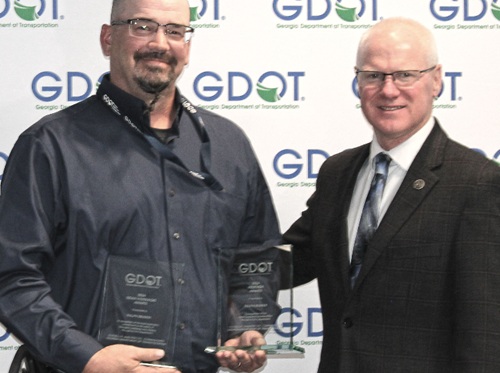During a recent tour of the Maine Western Gateways Project overseen by the Maine Department of Transportation, Governor Janet Mills (D) (seen above) highlighted the importance of infrastructure investments in strengthening her state’s rural economy.
[Above photo by the Maine Governor’s Office]
The $9.2 million Maine Western Gateways Project is Maine DOT’s initiative to revitalize the highway corridors that lead to Maine’s western mountains, including several ski slopes.

The project involves reconstructing and rehabilitating parts of Route 27 in Kingfield, Route 302 in Fryeburg, and Route 26 in Woodstock. It also includes sidewalk and shoulder improvements designed to enhance mobility and safety for bicyclists and pedestrians plus motorists and their passengers.
In addition to providing safer transportation options, the Maine Western Gateways Project will strengthen Maine’s economy as the roads under construction via this project provide access to rural forestlands that are vital to the forest industry, which supports more than 33,000 jobs and generates $8.5 billion in economic activity for Maine.
Those roads also provide access to western Maine’s recreation areas, including hiking trails, snowmobile trails, lakes, mountains, and streams, as well as winter ski resorts which are used for business conferences, weddings, mountain biking, and golfing during the summer months. The roads also connect Maine residents with Canada and neighboring New Hampshire, promoting cross-border commerce.
“The Western Gateways Project is the perfect example of how we can modernize rural infrastructure to ensure that our roadways are safe for people and strong for our economy,” said Gov. Mills in a statement. “This work … will strengthen the local economy, bolster the forest products industry, support tourism, and improve public safety.”

“The roads that are part of the Western Gateways Project are critical connections that support economic opportunity and quality of life in the villages in the western part of Maine,” said Bruce Van Note, Maine DOT’s commissioner. “This is how investments in infrastructure can make real differences in the lives of the people who live, work, and recreate in our great state.”
“Maine’s roads and highways help people get to work, support the safe transportation of goods and services, and help bring tourists to our state,” said Heather Johnson, commissioner of the Maine Department of Economic & Community Development. “The Maine Western Gateways Project will strengthen infrastructure critical to the health and vitality of Maine’s rural economy.”
Some 5,640 cars currently travel daily on Route 27 – originally constructed in 1950 – with daily use expected to grow to 6,770 cars by 2038. About 12 percent of that daily vehicular traffic is comprised of commercial trucks, the agency said.
Route 27 in Kingfield is part of the Maine Scenic Byway and provides access to Sugarloaf Ski Resort, which hosts 350,000 skiers annually. Kingfield is also home to a Poland Springs Water bottling plant, the fourth largest manufacturer in Franklin County.
Route 27 is also an important international commerce route, used by truckers for wood products headed to Fontaine Lumber in Quebec and to Stratton Lumber in Stratton – delivering wood chips to Stratton Energy, a 48-megawatt biomass electric generating plant, while trucks carry “quick lime” from Quebec to the paper mills in Rumford, Livermore, and Skowhegan.
The border crossing port at Coburn Gore is also the most direct route from Montréal and Sherbrooke, Quebec to Maine and the Maritimes, with Route 27 ending in Boothbay Harbor.
Maine DOT’s work in Kingfield will address the road’s numerous potholes, rutting, and weak side slopes; repair poor drainage; and update outdated guardrails to protect drivers from the Carrabassett River. It will also improve outdated pedestrian signage to improve safety.
 States
States
Georgia DOT Foreman Receives Two Heroism Awards
January 2, 2026 States
States

